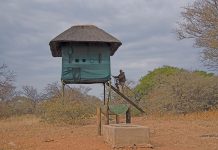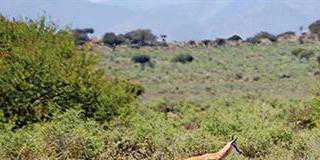
The wildlife industry’s battle cry “If it pays it stays,” also read as “only if it pays it stays,” or “if it pays it will be introduced,” or “if it pays, it will be created through selective breeding,” ignores fundamental conservation biology principles.
That’s according to Daan Buijs, of Biodiversity Scientific Support at the North West Department: Agriculture, Conservation, Environment and Rural Development. These are hard words, and Daan says them with apology to wildlife ranchers who manage their land and wildlife responsibly.
“There’s no question that conservationists appreciate the contribution of the wildlife industry towards the increase of certain species and transforming – although not necessarily rehabilitating – farming land into wilderness areas,” he says.
“The sustainable use of wildlife is also recognised as a sound form of conservation and is actively supported. But, there’s a limit to the extent that the private wildlife industry can conserve biodiversity – and that limit is currently being tested by an ignorance of natural systems and ecological processes.”
Daan explains that biodiversity includes millions of species of microbes, plants, invertebrates and other organisms that are often not considered or acknowledged by ranchers. “The introduction of, for example, 10 extra-limital large mammalian species onto an antelope ranch contributes only a fraction to what the industry deems as biodiversity. In fact, over time, such an introduction is likely to reduce the total scientifically defined biodiversity by a much larger proportion,” he says.
The National Environmental Management: Biodiversity Act, No. 10 of 2004 makes provision for the development of Alien and Invasive Species Regulations.
The aim is to prevent the unauthorised introduction and spread of alien and invasive species to ecosystems and habitats where they didn’t naturally occur; to manage and control alien and invasive species to prevent or minimise harm to the environment and biodiversity; to eradicate alien and invasive species from ecosystems and habitats where they may do harm; and to ensure that environmental assessments are conducted for purposes of permits.
After a series of workshops, the wildlife industry and conservation authorities reached a compromise in 2006 on the regulations on alien and invasive wildlife species as defined by the Act. However, Daan says that after the recommendation of the original task group was rejected, the old debate about the rights of extensive wildlife ranchers to ranch with any species, anywhere, flared up again.
In March 2008 the then Department of Environmental Affairs and Tourism hosted a workshop to discuss the draft of alien and invasive species regulations. Here, Daan charges, individuals who had not been part of the original task team of leaders and experts in the wildlife industry and conservation circles again derailed the process.
They presented several exhausted arguments in favour of their rights, while a new argument concerning global warming was added.
Their arguments are that:
- Game numbers are now higher than they were 100 years ago thanks to wildlife ranching’s positive contribution to biodiversity conservation.
- Extra-limital large mammals present no threat as they can easily be destroyed should they escape from a ranch.
- There’s not enough scientific information on many indigenous species to predict the degree of invasive potential that they may display when introduced into habitats where they did not occur naturally.
- More research by government is needed on this aspect.
- Indigenous species are South African and should therefore be deregulated throughout the country.
- There are restrictions on the movements of wildlife but none on domestic livestock that also damage vegetation and habitat.
- Global warming has created new habitats favourable to the introduction of new species.
- Analysing these arguments, Daan contends that biodiversity conservation has four levels – genetic; species; ecosystems and communities; and landscape. He concedes that game numbers might be much higher than 100 years ago, but he asks what contribution game ranching has made towards conservation on a genetic level.
- And then there’s the negative effect of ranching on natural communities and landscapes. Electric fences regularly kill leopard tortoises, pythons, pangolins and other mammals and amphibians.
An estimated 21 000 reptiles are killed annually by all the electric game fences in South Africa. Daan contends that many small, ecologically unviable game ranches are overstocked.
“The largest contributors to the so-called increase in South African biodiversity are foreign big game hunters who come to hunt real African game in their ‘natural’ environment. The point is that we not only have more game but also more varieties that wouldn’t normally have evolved in the wild under natural conditions. Many of these command very high trophy fees.”
Examples are: “black” springbok (R4 000), “white” springbok (R6 500), “copper” springbok (R15 000), “black” impala (R160 000), “black-backed” impala, “white” blesbok and “golden gnu” (black wildebeest) (R250 000).
He also notes that not all species are more numerous now than 100 years ago.
“The oribi, for example, is decreasing rapidly and is classified as endangered on the South African Red Data List. While viable populations are still protected on some commercial stock farms, they’re generally absent on game ranches as they have little commercial value.“
Safari Club International and Rowland Ward entries are mainly from countries such as Malawi, where there are, ironically, no game ranches. Also extensive grazing, often by extra-limital species, leaves grassland and wetland habitats too degraded for the oribi, who need wise habitat management in an enclosed system such as a game or cattle ranch. Daan adds that species with high conservation value are often worthless to the commercial sector.
“Because auctions prices are determined by horn length, the Zambian sable is imported and bred to ‘improve’ the local ecotype genetics,” he explains. “Almost all sable come from intensive breeding facilities because they are too valuable to release into natural habitat.
“The chosen ones, as sold by catalogue, are released into the veld only to be shot.
Game ranchers also remove predators that hunt (introduced) extra-limital species, such as leopard killing nyala on a game ranch in the Magaliesberg or cheetah catching blesbok in the Kalahari. The result is that the evolutionary process of survival of the fittest through natural selection is also removed from the system.”
Farm animals versus game
The wildlife industry, according to Daan, contends that if alien or invasive wildlife species are banned, alien livestock such as Merino sheep, Angora goats and European cattle should also be legislated against.
“Livestock may be alien, but are not invasive and are managed in rotational grazing systems. Game, on the other hand, are usually let loose on a ranch and left to fend for themselves until they are hunted. A well-managed stock farm is often in better condition than a game ranch is.”
He challenges another view. “Because conservation authorities are often accused of ignoring overgazing by domestic stock such as Boer Goats, game ranchers resent being regulated by permits.
“But legislation can be used to prevent overgrazing. Ranchers who use this argument should challenge the agriculture department instead of pressuring conservation authorities to throw conservation principles overboard. There is no move to get rid of any livestock species. In fact, a long list of livestock species are exempted under the current draft regulations on invasive species.”
Ranchers may demand that conservation authorities should first do research, but Daan points out that the authorities are not only under pressure from the wildlife industry to abandon the precautionary principle. Animal rightists want them to do more research to prove that elephants reduce biodiversity before resuming population control. Two groups, in total disagreement with each other, use the same tactics to delay conservation action.
“The Biodiversity Act provides for risk assessments in the case of species that could be problematic,” says Daan. “Before issuing a permit, the issuing authority may therefore ask for an independent risk assessment or expert evidence in support of the application (at the applicant’s expense). The demand for more research can lead to a situation where, if the industry does not fund the research, no more permits will be issued for potentially invasive species.”
Contact Daan Buijs on 083 320 2727 or at [email protected].













